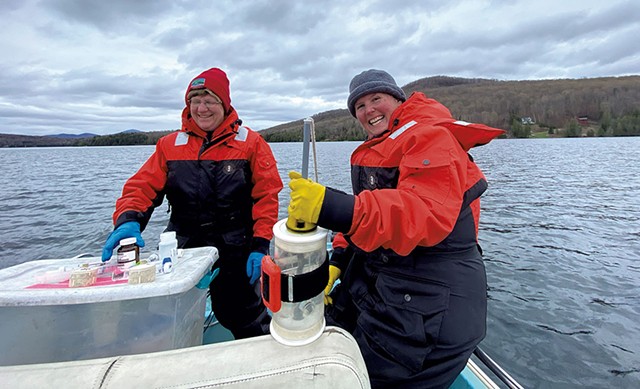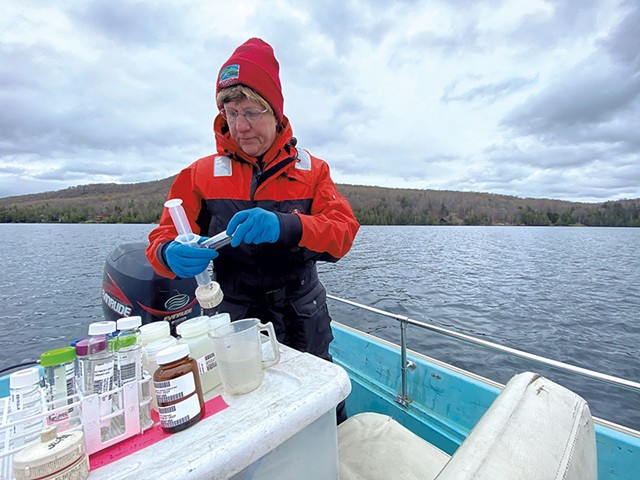
- Rachel Hellman
- Leslie Matthews (left) and Kellie Merrell
On an overcast morning in early May, a lone Boston Whaler gently bobbed on the gray waters of Seymour Lake. The three-mile-long lake near the Canadian border is fringed by homes, family camps and public beaches. In summer, it is a beloved place — and lively. In spring, though, it is quiet.
On board, a bespectacled woman, decked from head to toe in a bright orange survival suit, stood and went to work. Using a syringe-like plunger, she carefully drew samples of lake water and deposited them into test tubes, like a phlebotomist drawing blood from a patient.
Across the boat, her windswept, rosy-cheeked colleague, also in a neoprene survival suit, quietly counted the yards of rope she was pulling up from the water. The women were focused, moving through well-practiced motions with ease and care. They jotted notes on clipboards, retrieved tools from waterproof bags, sifted through nets.
From afar, it might have looked as if the pair were simply fishing in garish matching outfits. But in reality, the two women — Leslie Matthews, 61, and Kellie Merrell, 52 — had stopped their boat at precisely the deepest part of the lake, at 181 feet, to take measurements that would provide a valuable snapshot of Seymour Lake's health. The "outfits" would keep them buoyant and dry in case either one wound up in the water.
The duo has been working together for almost 12 years and is responsible for monitoring all of Vermont's large lakes after each spring thaw. Although a battalion of citizen scientists volunteer for similar work throughout summer, Matthews and Merrell, both biologists, are the only paid scientists collecting and analyzing data across Vermont's bodies of water larger than 10 acres, Lake Champlain excluded.
In the span of just four to six weeks each spring, Merrell and Matthews visit more than 70 lakes and take thousands of measurements. It's important to do this work soon after the thaw, which acts as a sort of blender mixing up lake sediments, thus offering scientists a handy sampling of what's in the water. With a seasonal clock ticking, the biologists have much work to do.
When lakes are inaccessible by car, Merrell portages their 40-pound canoe, sometimes for more than a mile. Matthews carries nearly 60 pounds of surveying tools. At times, they bushwhack, weaving through trees and brush.
Seymour Lake, easily reached, required no such heroics.
Over the years, the two have had to push their truck out of a ditch, endure surprise thunderstorms and contend with a failed boat motor in the middle of a lake. Merrell once accidentally left a wet suit on the beach after a day of snorkeling.
"But we've never left anything at the bottom of any lakes," she cracked mischievously, causing Matthews to burst into laughter.
After nearly two decades working together, Merrell and Matthews are no mere coworkers. Merrell likes to call Matthews her "work wife," a term of affection that has taken on meaning as Matthews readies for retirement next winter. They joke about writing a sitcom called "Lakes" about people with jobs like theirs. Hijinks might ensue.
Joshing aside, Matthews and Merrell are some of the leading scientists in their field, and their superiors at the state Agency of Natural Resources crow about their collective acumen. Matthews is responsible for having created a new way of visualizing data, and Merrell is a dogged advocate for legislation protecting Vermont's lakes.
On this day, the women worked with precision, their hands a flurry of practiced motion as they collected samples. Matthews used a spring-loaded device called a Kemmerer to capture water from a certain depth. She squirted water from the Kemmerer into plastic vials, which would be sent to a lab in Waterbury to be tested for various factors, including phosphorus content, turbidity, alkalinity and dissolved organic carbon levels.
From her side of the boat, Merrell dropped a Secchi disc, essentially a bull's-eye with a measuring tape attached, and watched as the target sank and receded from view. She recorded the depth at which it became invisible. In unhealthy lakes, she explained, the target might disappear at one foot. In Seymour Lake, it was closer to 29 feet — a good sign.
The visible health of Seymour Lake may owe at least partial thanks to their monitoring efforts. A few years ago, the duo noticed increasing phosphorus levels, inspiring the local residents to take action, such as growing vegetation near the waterfront. The levels eventually subsided.
That kind of vigilance pays off. The state's lakes are relatively clean — a recent survey ranked Vermont's fifth in the country in terms of clarity. ("We beat New Hampshire, which is all that matters," Matthews quipped.) The lake monitoring program they staff is one of the oldest in the country, dating back to 1977.
"We have the responsibility of protecting some of the best remaining waters in the nation," Merrell said.

- Rachel Hellman
- Leslie Matthews
They see plenty of reasons for concern, including the proliferation of invasive plant species that can choke lakes to death; Merrill and Matthews aren't monitoring that. Their data show rising rates of phosphorus, a common element in agricultural fertilizers and manure, over the years. Excess phosphorus feeds algae blooms, which turn lakes green and can be toxic. Lately, the pair has noted an increase in chloride levels as well, most likely the result of runoff from road salt. Recently, Merrell testified in front of Vermont legislators about S.146, a bill that aims to strengthen water quality standards, which did not pass this legislative session.
Working to protect bodies of water has been a career goal for Merrell for as long as she can remember. Her grandfather was a waterman on Chesapeake Bay, inspiring her to major in marine biology in college. Merrell's eyes brightened as she described the joys of working on the water. "Follow your bliss," she advised.
Matthews' path to the lakes was less straightforward. She got a PhD in molecular genetics, then worked at a lab developing a vaccine for malaria and later researching AIDS and SARS. Despite success, Matthews said, she was "really miserable."
She eventually landed a temporary gig with Merrell, working for Vermont's Agency of Natural Resources. The two immediately hit it off, but Matthews wasn't sure she was ready to switch course. A fortune cookie at a Chinese restaurant provided a push.
It read: "You could prosper in the field of medical research."
She first thought Merrell had planted the fortune to push her to quit and go back to her old work, but then saw the message as a sign to stay. "Nobody understands that," she said, "but I interpreted the message that way."
The natural world isn't the one the two biologists worry about. After finishing on Seymour Lake, Merrell pondered the root of the challenges facing their beloved Vermont lakes: "We've studied macroinvertebrates. We study fish. We study aquatic plants. We study diatoms. But humans—"
"Forget about it," Matthews said, finishing for her. They laughed in unison as they placed their filled vials in containers and brought up the anchor.
The tone turned more urgent as the scientists guided the boat back to shore. Merrell said a sustained effort was essential to keep the state's lakes healthy. "We have no time to lose," she said.
Merrell slowed the boat as it approached the dock, and Matthews hopped out to tie it off.
The women had spent many similar spring days collecting samples over more than a decade. But Matthews' retirement plans mean that the number of outings they have left together is dwindling.
The old friends peeled off their survival suits and pulled the boat back on land. There was time to check one more lake before the end of the day.










Comments
Comments are closed.
From 2014-2020, Seven Days allowed readers to comment on all stories posted on our website. While we've appreciated the suggestions and insights, right now Seven Days is prioritizing our core mission — producing high-quality, responsible local journalism — over moderating online debates between readers.
To criticize, correct or praise our reporting, please send us a letter to the editor or send us a tip. We’ll check it out and report the results.
Online comments may return when we have better tech tools for managing them. Thanks for reading.